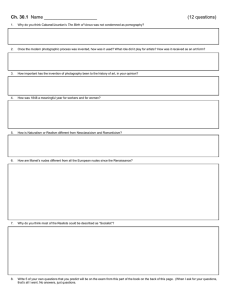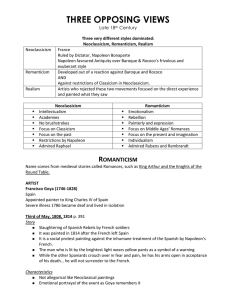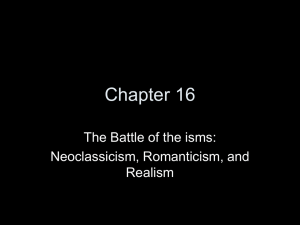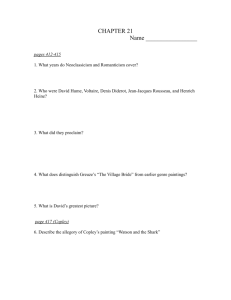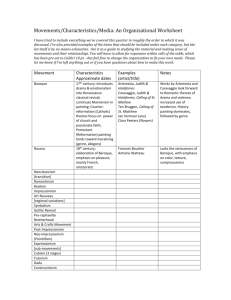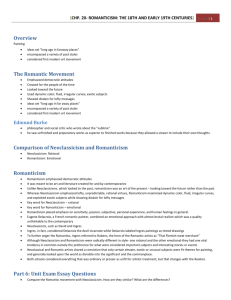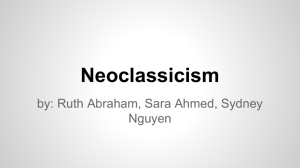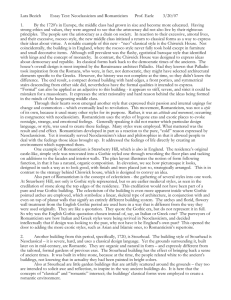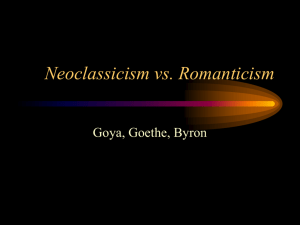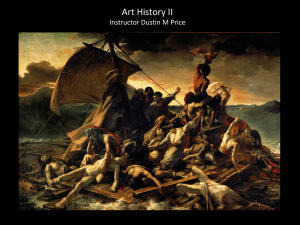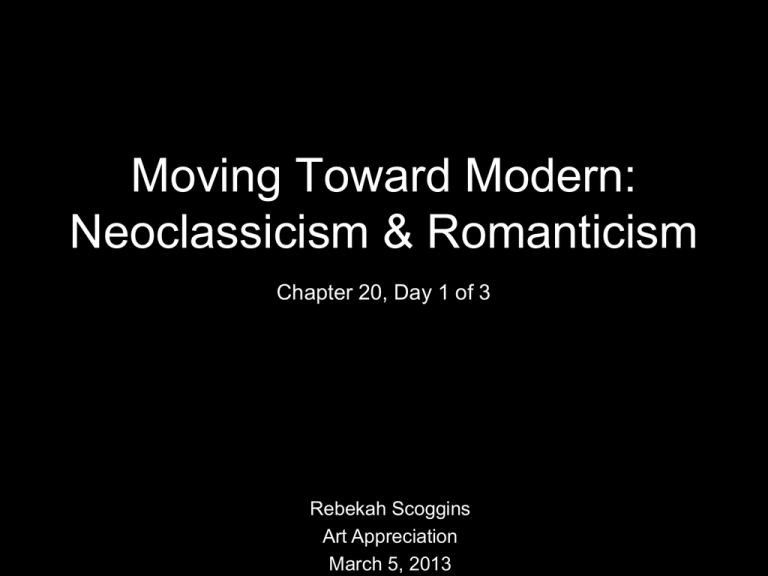
Moving Toward Modern:
Neoclassicism & Romanticism
Chapter 20, Day 1 of 3
Rebekah Scoggins
Art Appreciation
March 5, 2013
Factors that lead to Neoclassicism
o Industrial Revolution, began 1760
o American Revolution of 1776
o French Revolution of 1789
o Enlightenment – also known as the Age of Reason, was
the name that characterized the laste 18th century,
characterized by:
o The idea that people should be ruled by reason
o Shift to more rational and scientific approach to
religious, political, social, and economic issues
o Belief in the importance of liberty, self determination,
and process
o Renewed interest in democracy and secular concerns
Characteristics of Neoclassicism
• The emulation of classical Greek and Roman art
• Much of the subject matter in Neoclassical art
was Roman because Rome was a republican
government not ruled.
• Focuses on reason as most important aspect,
Enlightenment values
• Ordered; Calm
• Harmonious; Balanced
• Instructive, containing morals
• Socially conscious
Jacques-Louis David. Oath of the Horatii. 1784. Neoclassicism.
Jacques-Louis David. Death of
Marat. 1793. Neoclassicism.
Angelica Kauffmann. Cornelia, Pointing to Her Children as Her Treasures.
c. 1785. Neoclassicism.
Thomas Jefferson. Monticello. Charlottesville, Virginia. 1793–1806. Neoclassicism.
Jean-Auguste-Dominique Ingres. La Grande Odalisque. 1814. Neoclassicism.
Jean-Auguste-Dominique Ingres. La Grande
Odalisque (Detail). 1814. Neoclassicism.
Raphael. Cowper Madonna (Detail).
1505. Italian Renaissance.
Characteristics of Romanticism
• Believed the path to individual freedom was through
imagination, not reason.
• Had a desire for freedom, not only political, but also of
thought, feeling, action, worship, speech, and taste.
• Believe that imagination and emotion are more valuable
than reason
• Nature is less corrupt than civilization
• Human beings are essentially good
• Celebrated nature, rural life, common people, and exotic
subjects in art
• Believed in subjective experience & sought to escape
from fixation on classical form.
• Had painterly brushstrokes; you can see them in the
composition, unlike in the Neoclassical era, which
had invisible brushstrokes.
Francisco Goya. The Third of May, 1808. 1814. Romanticism.
Copyright ©2011, ©2009 Pearson Prentice Hall Inc.
Eugène Delacroix. The Death of Sardanapalus. 1827. Romanticism.
Copyright ©2011, ©2009 Pearson Prentice Hall Inc.
Eugène Delacroix. Liberty Leading the People. 1830. Romanticism.
Joseph Mallord William Turner. The Burning of the Houses of Lords and
Commons. 1834. Romanticism.
Copyright ©2011, ©2009 Pearson Prentice Hall Inc.
Thomas Cole. The Oxbow. 1836. Romanticism.
Copyright ©2011, ©2009 Pearson Prentice Hall Inc.
Thomas Cole. The Oxbow (Detail). 1836.
Romanticism.
Homework
Bring in a typed statement informing me which artist you
want to write about for your paper. Have at least two
artworks listed that you can choose from for your paper. You
paper due date is March 26th, so I want to make sure you
have at least picked an artist by this point.
Also, on your conference day, I expect you to bring at least
a page that you have written of your paper for us to discuss.
It doesn’t have to be finished, but I want to make sure that
you are going in the right direction.
Note: You may add more artworks later if you find another
piece by the same artist you like, but I want you to at least
have looked at a few works by the artist to ensure that you
can in fact find two substantial works to analyze.

